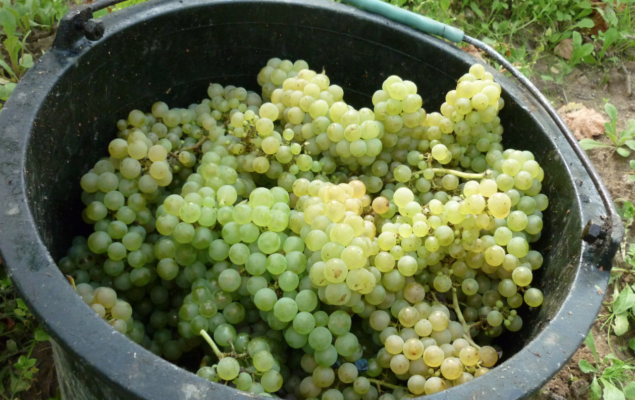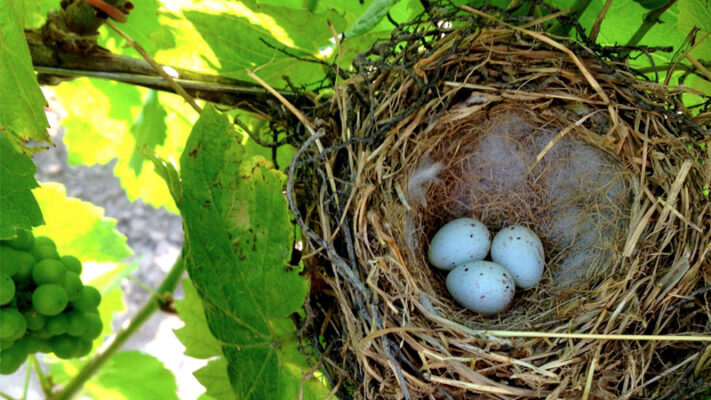To begin with, we’d like to share with you a quote that we are particularly fond of : « New opinions are always suspected, and usually opposed, without any other reason but because they are not already common. »»
John Locke – Philosophe anglais du 17ème siècle .
Origin
RUDOLF STEINER, Austrian philosopher and scientist, laid the foundation for Biodynamics in 1924 in response to farmers who – already at the turn of the 21st Century – had expressed concern regarding the health of their land and soil, as well as the declining quality of their food and seeds. Over the course of 8 conferences, known collectively today as the « The Agriculture Courses », STEINER demonstrates his views and proposes solutions using techniques designed to create a new system for agricultural production.
« Bio-dynamic agriculture is agriculture that ensures the health of the soil and plants to provide healthy food for animals and humans. It is based on a deep understanding of the laws of the “living” acquired through a qualitative/global vision of nature. It considers that nature is currently so degraded that it is no longer capable of healing itself and that it is necessary to restore to the soil its fertile vitality essential to the health of plants, animals and people thanks to “therapeutic” processes». . R.STEINER
The principles…
These techniques are largely based upon several core principles…
+ The enhancement of the soil and the plant in its natural environment by incorporating preparations from plant, animal, and organic matter.
+ The application of these preparations at specific times throughout the course of the year, paying special attention to the rhythms of nature. We take into account the lunar, cosmic and zodiac calendars but also the position of the planets, their alignment during the seasons and Circadian rhythms (see terrestrial and lunar rhythms above).
+ We recognize in the earth (bedrock, arable land and aerial environment) an organism in its own right. Akin to homeopathy, we care for our plants with specific treatments harnessing the life forces that surround us.
+ Working the soil by plowing, tilling and scratching.

Applying Biodynamics to Winegrowing :
Our vineyard, which covers 30 hectares, is considered a living organism in its own right. The cultivated soil is not just a foundation, or a simple substrate for the vine, but a living environment, a source of energy for the plant in the same way as its aerial environment.
Biodynamics aims to bring harmony and balance to the soil and the vine by bringing vitality and resistance. We “energize” the plant and its environment (earth, air) by spraying natural plant and mineral preparations. They are the basis of Biodynamics and are made from fermented or otherwise transformed plant, animal and mineral materials.
Natural compost made from manure, vegetable waste, soil and any natural vegetable or animal substance likely to be decomposed by micro-organisms and living beings in the compost, is called dung compost: it consists mainly of cow dung, basalt powder, eggshells and a mixture of the six biodynamic compost preparations (see above “other preparations”). It allows for good decomposition of organic matter in the soil and brings the “impulse” to biodynamic preparations by reinforcing the process of decomposition of the earth into humus.
It contains all the elements that help in the formation of the clay-humus complex thanks to the presence of numerous bacteria. This preparation is sprayed on the ground after a dynamization of 20 minutes at the rate of 240 g of compost dung per hectare for 40 liters of water.

The preparation known as 500 Horn Manure :
Preparation 500 is made from organic cow dung. This dung is introduced into a cow horn (Bio) emptied of its internal cartilage and buried during the winter period (between the winter solstice and the summer solstice). During this period, the dung undergoes a fermentation process and turns into natural humus. This preparation is then energized and then sprayed in large drops in the evening since it is intended for the soil: the content of one horn per hectare, i.e. approximately 200 to 250gr per hectare for 40 liters of water. This preparation plays a fundamental role in biodynamic agriculture: it promotes the root network (development, density, distribution) and remains a powerful builder of the soil structure by promoting underground life, microbial activity, and the formation of soil humus.
The preparation known as 501 Horn Silica :
Preparation 501 is made from finely ground quartz (crystalline silica) powder and introduced into an organic cow horn to be buried during the summer period (between the summer solstice and the winter solstice). This preparation is used as a spray on the vine during the vegetative period: this preparation is therefore not intended for the soil but for the aerial part of the plants. It mainly promotes photosynthesis (and therefore the creation of matter by promoting heat and light) but also leaf development, flower development, and fruit set depending on when it is applied. 501 effectively strengthens the link between the vine and the sun and at the same time promoting the effect of photosynthesis – largely responsible for taste, color, aromas and harmony in your glass… Prior to flowering, 501 promotes the growth of vine shoots; after flowering, it will promote, among other things, the maturity of the fruit. 501 is also a valuable ally in the fight against cryptogamic diseases, specifically downy and powdery mildew. If the balance is reached in the biotope, the vine will defend itself – or more accurately, it will “refuse to welcome” the parasite. This preparation is then dynamized for one hour and sprayed in fine droplets at daybreak (never after 8:00 AM, i.e. just 1 hour after theoretical sunrise): the content of one teaspoon per hectare is sufficient, i.e. around 4 gr per hectare for 40 liters of water.
The effectiveness of these treatments is linked to the complementarity of the preparations (500 & 501); to put it simply, the 501 allows you to capture an increase in light which must be compensated by a good strength of the soil, otherwise the plant will be completely unbalanced…
Other préparations
We may also act to help the plant defend and develop itself by spraying herbal teas, decoctions or homeopathic dilutions of plants. Here is a non-exhaustive list of the most popular plants in Biodynamics.
- 502: Yarrow, potassium regulation
- 503: Matricaria chamomile, calcium regulation
- 504: Stinging nettle, iron regulation
- 505: Oak bark, regulation of the fruiting process
- 506: Dandelion, silica process regulation
- 508: Valerian, phosphorus regulation
One must also understand that each of these preparations meets strict production protocols to obtain maximum effectiveness on the plant.
Les rythmes terrestres et lunaires
These biodynamic treatments are performed during precise time slots of cosmic conjunctions. By rotating around the earth, each month, the Moon passes in front of the 12 constellations of the zodiac whereas the sun does so over the course of a year. The use of this rhythm (known as sidereal rhythm) was popularized by Maria Thun who, through her experiments, made it possible to highlight the cosmic influences on the development of plants. A calendar of treatments is now established every year determining Root, Leaf, Flower and Fruit days… The work and treatments of the vine can be magnified by the choice of the dates of intervention. We therefore administer these preparations according to the cycle of the stars… Esoteric you say? Come and see for yourself the health and vigor of our vines…
We also take into account the rhythm of the Moon, called “synodic rhythm” but all good gardeners (even hairdressers) will be able to discuss the benefits or harms of waxing and waning moons…
Dynamisation, or when Organic becomes BioDynamic :
To be effective, these preparations are “dynamized”; by dynamization, we mean the fact of diluting the preparations in water (recovered rainwater or spring water). For our part, we use the water from our well which is brewed in a large copper receptacle of 350 liters in the open air (mechanical dynamizer invented by Alex Podolinsky and developed by Ulrich Shreier). A giant mixer, like a food processor, is connected to a small electric motor and allows the formation of a whirlwind (vortex) followed by a sudden stop and directional change, causing energetic chaos. From right to left, from left to right, the cycles follow one another without interruption for a determined time (from 20 minutes to 1 hour). According to R.Steiner, it is this chaos that energizes the preparation.
The dynamized preparations are then immediately sprayed to come into contact with the soil or the plants.
Tilling and Plowing :
Working the soil is essential because it promotes and maintains soil life; it can be done in different months or at different times of the day depending on the objective. Plowing in lunar spring will have a different effect than plowing in lunar autumn. These concepts of lunar spring and autumn are established by what is called the sidereal rhythm (the duration of which differs only by 7 seconds from the circadian rhythm). During its monthly cycle, the Moon comes to its lowest position (southern lunistice) in front of the constellation Sagittarius. From there, it begins to ascend and form an arc in the sky circling larger and higher each day: this is the Lunar Spring. During this period, the sap flow within the vines is stronger; this is the period chosen, among other things, for grafting. Once it has reached the highest point of its monthly trajectory (north lunisticus) in front of the constellation of Gemini, the Moon begins to descend: Lunar Autumn is traditionally favorable for pruning, planting or adding compost.
Let’s not forget either that hoeing in the morning will revitalize the vine and that hoeing carried out in the afternoon will promote water retention in the soil… There are therefore many combinations. It is up to each winegrower to adapt his cultural practices to his needs.
Ultimately, we claim Biodynamics in addition to organic farming in viticulture because it makes it possible to effectively overcome the problems linked to the imbalances inherent in any monoculture.
Here’s hoping I’ve been able to be clear, concise, and informative.
Fred
